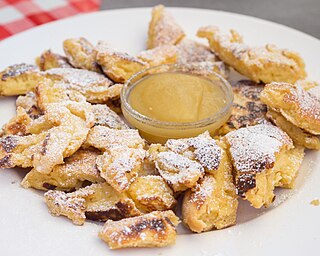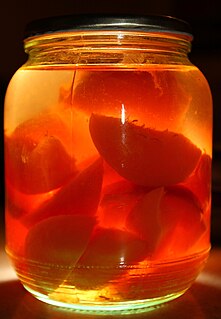
Hungarian or Magyar cuisine is the cuisine characteristic of the nation of Hungary and its primary ethnic group, the Magyars. Traditional Hungarian dishes are primarily based on meats, seasonal vegetables, fruits, fresh bread, dairy products and cheeses.

A crumble is a dish of Irish origin that can be made in a sweet or savoury version, although the sweet version is much more common. A sweet variety usually contains stewed fruit topped with a crumbly mixture of fat, flour, and sugar. A savoury version uses meat, vegetables and sauce for the filling, with cheese replacing sugar in the crumble mix. The crumble is baked in an oven until the topping is crisp. The dessert variety is often served with ice cream, cream, or custard. The savoury variety can be served with vegetables.

Austrian cuisine is a style of cuisine native to Austria and composed of influences from Central Europe and throughout the former Austro-Hungarian Empire. Austrian cuisine is most often associated with Viennese cuisine, but there are significant regional variations.
Croatian cuisine is heterogeneous and is known as a cuisine of the regions, since every region of Croatia has its own distinct culinary tradition. Its roots date back to ancient times. The differences in the selection of foodstuffs and forms of cooking are most notable between those in mainland and those in coastal regions. Mainland cuisine is more characterized by the earlier Slavic and the more recent contacts with Hungarian and Turkish cuisine, using lard for cooking, and spices such as black pepper, paprika, and garlic. The coastal region bears the influences of the Greek and Roman cuisine, as well as of the later Mediterranean cuisine, in particular Italian. Coastal cuisines use olive oil, and herbs and spices such as rosemary, sage, bay leaf, oregano, marjoram, cinnamon, clove, nutmeg, and lemon and orange rind. Peasant cooking traditions are based on imaginative variations of several basic ingredients and cooking procedures, while bourgeois cuisine involves more complicated procedures and use of selected herbs and spices. Charcuterie is part of the Croatian culinary tradition in all regions. Food and recipes from other former Yugoslav countries are also popular in Croatia.

Singaporean cuisine is diverse and contains elements derived from several ethnic groups, as a result of its history as a seaport with a large immigrant population. Influences include the cuisines of the native Malays, the largest ethnic group, the Chinese and the third largest ethnic group, the Indians as well as Indonesian, Peranakan and Western traditions. Influences from other regions such as Sri Lanka, Thailand and the Middle East are also present.

Burmese cuisine includes dishes from various regions of Myanmar. The diversity of Myanmar's cuisine has also been contributed to by the myriad local ethnic minorities. The Bamars are the most dominant group, but other groups including the Karen people also have distinct cuisines.

Kaiserschmarrn or Kaiserschmarren is a shredded pancake that takes its name from the Austrian emperor (Kaiser) Franz Joseph I, who was very fond of this kind of fluffy shredded pancake.

Czech cuisine has both influenced and been influenced by the cuisines of surrounding countries. Many of the cakes and pastries that are popular in Central Europe originated within the Czech lands. Contemporary Czech cuisine is more meat-based than in previous periods; the current abundance of farmable meat has enriched its presence in regional cuisine. Traditionally, meat has been reserved for once-weekly consumption, typically on weekends. The body of Czech meals typically consists of two or more courses; the first course is traditionally soup, the second course is the main dish, and the third course can include supplementary courses, such as dessert or compote. In the Czech cuisine, thick soups and many kinds of sauces, both based on stewed or cooked vegetables and meats, often with cream, as well as baked meats with natural sauces (gravies), are popular dishes.

Kolak is an Indonesian dessert based on palm sugar or coconut sugar, coconut milk, and pandanus leaf. A variation in which banana is added, is called kolak pisang or banana kolak. Other variations may add ingredients such as pumpkins, sweet potatoes, jackfruit, plantains, cassava, and tapioca pearls. It is usually served warm or at room temperature.

A fool is an English dessert. Traditionally, fruit fool is made by folding pureed stewed fruit into sweet custard. Modern fool recipes often skip the traditional custard and use whipped cream. Additionally, a flavouring agent like rose water may be added.

The cuisine of Senegal is a West African cuisine influenced by North African, French, and Portuguese cuisine and derives from the nation's many ethnic groups, the largest being the Wolof. Islam, which first penetrated the region in the 11th century, also plays a role in the cuisine. Senegal was a colony of France until 1960. Ever since its colonization, emigrants have brought Senegalese cuisine to many other regions.

Qubani ka meetha is an Indian sweet made from dried apricots originating from Hyderabad. It is a common feature at Hyderabadi weddings.

Quince paste is a sweet, thick jelly made of the pulp of the quince fruit. Quince paste is a common confection in several countries.

Kavurma is a broad type of fried or sautéed meat dish found in Turkish cuisine. The name also refers to canned or preserved versions of a similar dish, prepared by dry frying the meat to render down the fat.
Bahamian Cuisine is to the foods and beverages of The Bahamas. It includes seafood such as fish, shellfish, lobster, crab, and conch, as well as tropical fruits, rice, peas, pigeon peas, potatoes, and pork. Popular seasonings commonly used in dishes include chilies, lime, tomatoes, onions, garlic, allspice, cinnamon, rum, and coconut. Rum-based beverages are popular on the island. Since the Bahamas consist of a multitude of islands, notable culinary variations exist.














